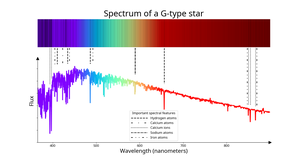Glossarbegriffe: G-Stern
Description: Ein Stern mit der Spektralklasse "G". Astronomen erkennen G-Sterne daran, dass ihr Spektrum starke Absorptionslinien von ionisiertem Kalzium aufweist. Ganz allgemein sind die Absorptionslinien von Metallen in Sternen des G-Typs stärker ausgeprägt als in heißeren Sternen (z. B. F-Sternen) und schwächer als in kühleren Sternen (z. B. K-Sternen). Sterne des Spektraltyps G haben typische (effektive) Temperaturen zwischen etwa 5200 Kelvin (K) und 6000 K. Im Vergleich zu anderen Sternen erscheinen sie dem menschlichen Auge gelb, es sei denn, die interstellare oder atmosphärische Extinktion spielt eine Rolle. G-Sterne, die Hauptreihensterne sind (d. h. in ihrem Kern durch Kernfusion Wasserstoff zu Helium verbrennen), werden als Gelbe Zwerge bezeichnet. Die Sonne ist ein Beispiel für einen Stern der Spektralklasse G, der ein Gelber Zwerg ist.
Zugehörige Glossarbegriffe:
See this term in other languages
Term and definition status: The original definition of this term in English have been approved by a research astronomer and a teacher The translation of this term and its definition is still awaiting approval
The OAE Multilingual Glossary is a project of the IAU Office of Astronomy for Education (OAE) in collaboration with the IAU Office of Astronomy Outreach (OAO). The terms and definitions were chosen, written and reviewed by a collective effort from the OAE, the OAE Centers and Nodes, the OAE National Astronomy Education Coordinators (NAECs) and other volunteers. You can find a full list of credits here. All glossary terms and their definitions are released under a Creative Commons CC BY-4.0 license and should be credited to "IAU OAE".
If you notice a factual or translation error in this glossary term or definition then please get in touch.
Related Diagrams
Spectrum of a G-type star
Bildnachweis: IAU OAE/SDSS/Niall Deacon
License: CC-BY-4.0 Creative Commons Namensnennung 4.0 International (CC BY 4.0) icons









